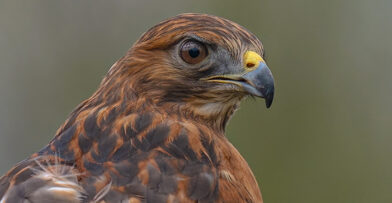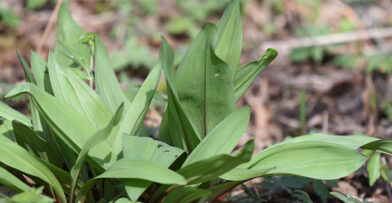Schlitz Audubon’s trails meander through nearly 30 acres of wetlands, offering ample opportunities to spot the diverse species of birds they attract. Wetlands exhibit several traits that distinguish them from other ecosystems found in our region. Containing water for at least part of the year, they have highly saturated soil. As a result, plants found in wetlands have unique adaptations that allow them to live in aquatic or semi-aquatic conditions. Emergent plants grow with their roots underwater and have leaves that extend above the water’s surface, like cattails and water lilies. Submerged plants dwell below the surface, providing food and shelter for fish, amphibians, and invertebrates. This beautifully complex community attracts a variety of bird species which rely on wetlands for food, shelter, nesting habitat, and as a migratory stopover site.
Abundant Food for Waders
Wetlands provide ideal habitat for fish, amphibians, small mammals, and invertebrates –key food sources for large wading birds like the iconic Great Blue Heron (Ardea herodias). Sporting bluegray plumage and able to reach a statuesque height of four feet, the Great Blue Heron’s long legs allow them to wade into the shallows and hunt for their prey by sight. Once their prey is in reach, herons extend their necks with a quick burst, grasping their meal with spear-like bills.
The Great Egret (Ardea alba), another member of the Heron family, displays bright white plumage, a long yellow bill, and black legs. This impressive species stands at nearly three feet tall, wading and hunting in the same manner as the Great Blue Heron. In the nineteenth century, Great Egrets were nearly hunted to extinction when it became fashionable to adorn hats with their stunning feathers. The newly formed Audubon Society began the conservation movement which would go on to protect egrets and other birds hunted for their feathers.
Secretive Marsh Birds
A marsh refers to a type of wetland with water depths between six inches and six feet. They are often dominated by tall emergent plants, such as cattails or wild rice. Large marshes, like Horicon Marsh, may contain areas of open water resembling small lakes, as well as shallow areas that occasionally dry up. Birds take advantage of the opportunity to hide in the dense vegetation scattered throughout marshes. Some bird species are so adept at camouflaging that birders and field researchers find it difficult to locate them by sight alone!
The Sora (Porzana carolina), about the size of an American Robin, looks petite compared to other members of the Rail family. Soras have a uniquely patterned coloration of brown and gray feathers, contrasting with a bright yellow bill and legs. They flick their short tails while strutting through the marsh, picking up seeds and invertebrates to eat along the way.
The American Bittern (Botaurus lentiginosus) showcases some of the best camouflage of any wetland bird. A little larger than crows, American Bitterns are medium-sized members of the Heron family. Their vertically streaked plumage in shades of brown allow them to blend in seamlessly with reeds and cattails. These birds stand remarkably still and are known to extend their long necks towards the sky to become virtually indistinguishable from the surrounding plants.
Nesting Sites
Accessible water and plentiful tall emergent plants also make wetlands ideal nesting sites for the Red-winged Blackbird (Agelaius phoeniceus). Males possess an unmistakable plumage of black feathers, set off by bright red and yellow wing patches. In contrast, females have a streaky brown appearance. Typically, they build nests low to the ground or water’s surface, using cattail leaves for support. Breeding Red-winged Blackbirds, males and females, become highly aggressive when defending their territories, as anyone who has gotten too close to a nesting site will attest!
Forested wetlands, such as hardwood swamps, floodplain forests, and woodland rivers and ponds, provide excellent nesting conditions for the Wood Duck (Aix sponsa). Unlike any other Wisconsin waterfowl, they perch on branches and nest in tree cavities around 25 feet off the ground! Soon after hatching and unable to fly, ducklings leap out of their cavity and land with a splash if there is water below. If the tree is on dry land, ducklings may take a bounce or two on the ground. They do not get hurt because at this age they are mostly fluff and cartilage. The female immediately leads the ducklings to water, which can be up to a mile away. This family unit remains in their wetland habitat until the young are able to fly.
Waterfowl Refuges
As summer progresses, many ducks and geese favor wetlands over the waterbodies they frequented in spring. At this time, waterfowl begin to molt out of their breeding plumage. Waterfowl go through a synchronous molt, meaning they replace all their feathers over the course of a few weeks. During this process they are unable to fly, so they take shelter in wetlands. Areas with both open water and dense vegetation offer the best protection from predators.
The new feathers are called an eclipse plumage because the “brilliance of the males is dimmed.” Males come to more closely resemble their female counterparts for a time, until they molt into their breeding plumage once again. This transformation is especially apparent in Mallards (Anas platyrhynchos) as their head turns from a brilliant emerald to mottled green to dull brown.
Wetland Birds of Schlitz Audubon
Visitors have many opportunities to observe wetland birds from our trails throughout the year. In the summer, Eastern Kingbirds (Tyrannus tyrannus) perch on the overhanging branches of Mystery Lake, taking short flights to catch insects and returning to the same perch. The Belted Kingfisher (Megaceryle alcyon) finds an overhanging branch a bit higher up and uses it to scope out fish in the water below. The Kingfisher takes off into a headfirst dive, splashing down to catch a minnow and swallow it whole.
In autumn, migration begins as birds fly south to their wintering grounds. Wetlands tend to be dryer this time of year, exposing areas around the edges of ponds where migrating sparrows stop to forage. On quiet fall evenings, a Barred Owl (Strix varia) can be heard calling to his mate across the canopy of Turtle Pond. They will soon be ready for the nesting season in the forest’s hidden wetland.
As winter sets in, diving ducks like Greater Scaup (Aythya marila), Common Goldeneye (Bucephala clangula), and Bufflehead (Bucephala albeola), congregate in the open water of Lake Michigan, and can be seen from our beach with a spotting scope.
When snow and ice begin to melt, migration is already underway again for many birds. Shorebirds journey a great distance to their breeding grounds in Canada. The shallow wetlands of Teal Pond and Molly’s Pond offer a valuable stopover site for birds like the Solitary Sandpiper (Tringa solitaria). Probing the pond’s edge, they forage in the mud for the food needed to fuel a long migration. The Blue-winged Teal (Spatula discors), a small dabbling duck, arrives in late March and takes refuge among the aquatic plants emerging from the shallows of Mystery Lake.
Spring is an active time for the Center’s wetlands. In April, American Woodcocks (Scolopax minor) take flight in the evenings to perform their famous “sky dance.” The wet prairie between Dragonfly Pond and Teal Pond provides excellent cover for nesting Woodcocks. In May, the ground-dwelling Northern Waterthrush (Parkesia noveboracensis) visits ephemeral ponds for an essential stopover during migration. Springtime wetlands offer prime nesting habitat for a variety of birds. Canada Geese (Branta canadensis) and Mallards build ground nests on the island of Mystery Lake. If you visit in April and May, you can see these waterfowl families swimming along with fuzzy goslings and ducklings in tow.


